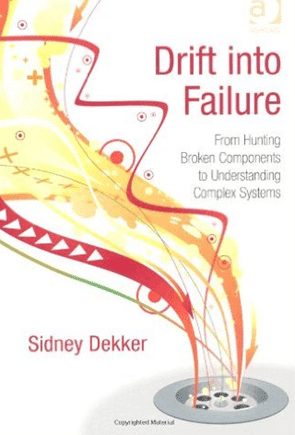Getting The Drift, Dekker on Safety
 I read many risk and safety books and most don’t go on the shelf but in the bin. Most regurgitate tired old safety myths, spin about behaviourism or target vigilance or zero for ineffective strategies in safety. Many of the books brand their central thesis in the language of the latest fad but retreat back to the same old constructs about human error, damaging energies, behaviourism and rationalist reductionism. How delightful then was it to read Dekker’s book Drift Into failure. Not the title I’d pick but nonetheless a brilliant critique on the worldview of the safety industry.
I read many risk and safety books and most don’t go on the shelf but in the bin. Most regurgitate tired old safety myths, spin about behaviourism or target vigilance or zero for ineffective strategies in safety. Many of the books brand their central thesis in the language of the latest fad but retreat back to the same old constructs about human error, damaging energies, behaviourism and rationalist reductionism. How delightful then was it to read Dekker’s book Drift Into failure. Not the title I’d pick but nonetheless a brilliant critique on the worldview of the safety industry.
Drift into Failure launches from page one into the Newtonian-Cartesian (reductionism) construct that plagues the mindset of the safety industry. It demonstrates how ‘rational choice theory’ underpins how safety sees the world and how it constructs its understanding of the world through the lens of this worldview.
In this book, Dekker explores the issue of complexity, I would perhaps prefer that he had suggested ‘wickidity’ was the issue but I come from a different academic tradition. (Further see http://www.enablingchange.com.au/wickedproblems.pdf) What Sidney shows is that the safety industry doesn’t understand complexity, emergence or how it has been entrapped into a reductionist mindset. Good old ‘cause and effect’ pulses through the arteries of safety and amplifies its self understanding.
Whilst I would prefer the use of the word ‘emergence’ over the use of ‘drift’, Dekker does use the notion of emergence to discuss safety beyond the confines of ‘cause and effect’. It would be a mistake to think that Dekker believes in incrementalism (http://www.enablingchange.com.au/wickedproblems.pdf ). I especially enjoyed the section where he explained a complex aircraft accident investigation he conducted that had no cause. In the complexity and ‘wickidity’ of the event, the accident ‘emerged’ and didn’t match the traditional ‘cause and effect’ paradigm of traditional safety. What is clear, the safety industry has invested in the Newtonian-Cartesian worldview so much, it either makes everything fit its assumptions of explains away what doesn’t fit. Like counting the number of times an organization doesn’t achieve zero.
The attention Dekker gives to the importance of language is critical as he states: What we need is a language that can help us get to a more functional account … whose constructions of meaning co-evolve relative to a set of environmental conditions, and who try to maintain a dynamic and reciprocal relation with the understanding of those conditions.’ (p. 49). In other words safety needs a better worldview (discourse) that helps understand reality and wickidity.
The reductionist view that: ‘collectively, they assert that action in the world can be described as a set of causal laws, with time reversibility, symmetry between cause and effect, and a preservation of the total amount of energy in the system’ (p. 85) loves barriers. There is nothing more important to safety reductionism than the bollard, symbol of all that safety is about. Distracted by hazards as the reality of risk rather than understanding people, safety thinks that its whole ‘raison d’etre’ is finding objects as cause. The symbol for the barrier delusion is the outdated reductionist idea of swiss cheese. All cause is systematic, knowable and preventable. Dekker’s book exposes the weakness of this idea (p. 90ff) and how it drives the crusade for ‘broken parts’.
‘Drifting into failure is not so much about breakdowns or malfunctioning of components, as it is about organisations not adapting effectively to cope with the complexity of its own structure and environment’ (p. 121). The answer to this predicament is not ‘resilience engineering’ but ‘organic resilience’. Unfortunately, the tradition of engineering language feeds the discourse of reductionist worldview. Dekker then discusses the importance of understanding complex systems theory, I would suggest the safety industry should extend this understanding to the notion of wickidity.
The key in understanding Dekker’s thesis is on page 155 on the notion of ‘emergence’, such a critical idea for battling the delusion of reductionism. Once one understands the problem then one understands that the mindset of solutions is not helpful but rather adaptation and resilience in the face of complexity should pervade safety discourse. The language of by-products and trade-offs (Amelberti – Navigating Safety) should be in the air safety people breathe rather than the talk of hazards and bollards. A great read on the issue of emergence is by Letiche, Lissack and Schultz, ‘Coherence in the Midst of Complexity’.
Dekker concludes with practical and pragmatic actions and a new pathway to take in thinking and doing (ontology) at the close of the book (‘A Post-Newtonian Ethic for Failure in Complex Systems’ pp. 198 ff).
Great to read a safety book that concludes an emphasis on the importance of relationships, interdependence and interconnectedness of people and systems (p. 201). I would recommend Sidney’s book as foundational reading for any safety person.



Do you have any thoughts? Please share them below